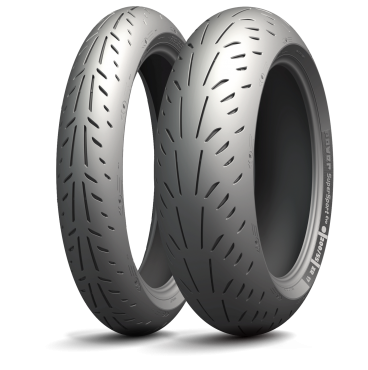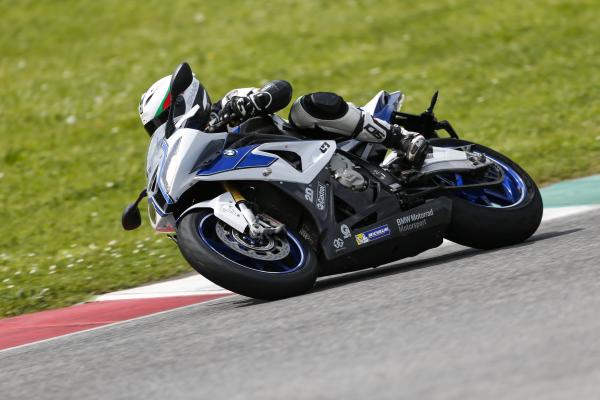Michelin SuperSport Evo and Power Cup Evo tyre review
Six new tyres in Michelin's high performance range, we test the two you need to know about

Member for
54 years 8 monthsTHAT'S me in the pictures riding Yamaha’s new R1, a BMW HP4 and the new Aprilia RSV4 RF on track in Italy. And yes, I do have a smug face right now.
It probably looks like the start of a superbike group test but we were there to test Michelin’s new range of high performance street and track tyres at Mugello.
I’m admittedly a big fan of Michelin’s road range, especially the Pilot Road 4s I tested on my KTM supermoto - brilliant tyres with silly amounts of grip in the wet. Durable too. Saying that, I’ve always steered clear of their track day rubber, mainly because I never really understood what was on offer.
There seemed to be a million and one choices in Michelin’s range and if you were lucky enough to have decided on one, you then had to choose if you wanted it in compound A, B or C - a dyslexic’s worst nightmare. I always worried I’d end up somewhere on track in the kitty litter with a very broken bike wondering if I’d chosen the wrong compound.
But now Michelin’s done away with the numerous alphabetical compounds and introduced what they call Adaptive Casing Technology (ACT), which changes the tyre’s rigidity depending on lean angle. It means you can have a big contact patch in a straight line and then an increasingly rigid tyre shoulder during big leans to help with stability. It’s like having semi-active suspension technology built into a tyre, except without all the electronics to go wrong.
So the range now includes a new supermoto tyre, the Power SuperSport Evo, a new Power Cup Evo and Power Slick Evo. There’s also a Power Cup Ultimate and Power Slick Ultimate, although they’ll only be sold by specialist dealers for racing.
SuperSport Evo
The first tyre we tried was the SuperSport EVO, a road-legal tyre designed to cope with all types of weather but still able to hold its own on the occasional track day. On identical bikes, Michelin says it will slash two seconds off your lap times around Cartagena compared to its predecessor.
So we wobbled out of pitlane around a slightly damp Mugello to get some heat into the cold tyres. It only took a lap before the front end offered enough confidence for heavy braking and knee-down lean angles, suggesting warm-up time on the road could be impressive too.
The chicanes through corners two/three and four/five highlighted decent turn-in speed and change of direction as you flick-flack your way through the first part of the circuit. Coming out of corner five you drive through second and third gear downhill into an off-camber right-hander. Even on the new 200hp Yamaha R1 the SuperSport Evo would happily hook up with the bike still on its side, giving you a little power wheelie on corner exit.
Through some of the faster corners there was a bit of movement from the rear tyre under heavy acceleration but it was always predictable and offered plenty of warning. No big slides or anything scary, just a bit of squirming to be expected when you’re pushing superbike-levels of power through a road-biased tyre.
Unlike an out-and-out track tyre you can’t completely take the Mickey with the SuperSport Evo rubber. You’ll eventually find the edge of grip if you start going for silly lean angles but as road-legal track worthy rubber comes, the Michelin’s are very good at both the front and rear end. Even on bikes with poor suspension setups, the front tyre did an impressive job of staying stable at high speed and under heavy braking. The first corner at Mugello is sat behind a blind crest so you have to accelerate over the hill at 170mph and then wait for the front suspension to settle before braking. It’s pretty scary but the SuperSport remained stable under the main bout of braking whilst remaining agile enough to let you move the bike into the apex as you started to peel off the brakes.
Power Cup Evo
If outright grip is more important to you than durability then the road-legal Power Cup Evos are definitely worth a try. Within several laps my best time had already dropped by four seconds compared to the SuperSport Evos.
There’s loads of grip, a ton of feel, and a profile that allows for both stability and decent change in direction. Compared to Michelin’s road-biased tyres, the Power Cups let you get on the throttle that second earlier, pull tighter lines and keep the throttle pinned when the rear starts to move a bit. It’s like riding on the SuperSport tyres with an extra 30% of performance in reserve.
Grip is just as impressive up front as it is on the rear tyre. Round the long double right-hander at the back of the circuit you get a fair amount of movement from the front end as it goes light over the crest under power. All the feedback that you need is on offer though and the rubber did a perfect job of keeping the bike composed as you transition from a shaking front end to heavy braking at turn 10.
Without data-loggers and days of back-to-back testing it’s impossible to say if the Michelins offer better lap times than other rubber on the market - what we do know is that the SuperSport Evo and Power Cup Evo both offer high levels of grip, stability and feel great on track even under the attack of 2015's most powerful sports bikes.
Nine interesting facts about Michelin’s new hypersport range
2,800 - The number of hours spent on development work
15 - The project timescale in months from the first prototype to market
15 - The number of tracks used for testing, including Mugello, Misano, Jerez and Portimao
25 - The number of racers who tested the new ranges on track, including Kenny Noyes
50 - The number of test sessions during track days and races
500 - The number of tyres tested
10,000 - The weight in kilograms of the rubber compounds tested
14,000 - The distance in kilometres covered at different circuits during testing
300 - The number of knee-sliders used during test sessions
















